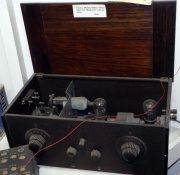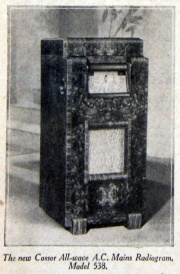A. C. Cossor


























of Cossor House, Highbury Grove, London, N5. Telephone: North 4340. Cables: "Amplifiers, London".
1859 Alfred Charles Cossor established a company in Clerkenwell, to manufacture scientific glassware.
1875 Alfred's eldest son, also called Alfred Charles Cossor, joined the company
1885 The younger son Frank Cossor joined the company, presumably Alfred Cossor and Sons.
1902 The company produced the first British made Braun tube (cathode ray tube)
1904 Experimental valves were produced by Cossor for Ambrose Fleming.
c.1907 William Richard Bullimore joined the company.[1]
1908 A. C. Cossor left his father's business to found his own company as a private company making scientific and electrical instruments. The expertise in the manufacture of electrical glassware, such as early cathode ray tubes and X-Ray tubes, allowed the company to diversify later into electronics.
1909 Frank eventually took over the running of the scientific glassware company which continues to this day as Accoson, a manufacturer of sphygmomanometers.
1910 A. C. Cossor and Co exhibited at the Physical Society's Exhibition.[2]
By 1911 Alfred Charles Cossor had retired. At some point W. R. Bullimore had gained a controlling interest in the company; he went on to develop the first thermionic valves that Cossor marketed, incorporating market leading technology[3]
WWI During the first world war the company was one of the first to produce valves in quantity for the war effort including large numbers of type R valves, a generic valve design produced by several other companies.
1918 The company moved to Highbury, to a factory called the Aberdeen Works. The office building which was called Cossor House, is still standing and now forms part of London Metropolitan University campus. Many of the buildings interior art deco furnishings remain untouched.
Post-WWI the company produced its first radio sets in kit form.
1921 Scientific instrument maker[4]
1924 Cossor introduced the first British valves to incorporate an oxide coated filament.
1926 Ceased manufacture of filament lamps[5].
1927 Company launched its famous "Melody Makers" radio sets - these constructor kits did much to popularise radio.
1929 Advert for Radio Receiving Valves. Also as makers of H. T. Eliminators; Trickle Chargers; L. F. Transformers; Loud Speakers; Motor Bulbs. Tuning Coils; Valve Holders; and complete kits of nparts for the construction of the "Cossor Melody Maker". Screened Grid Sets. Electric Lamps and Signs. (Wireless Section - Stand Nos. MM.31, MM.32 and MM.33)
1930 First British RF pentode valve was made by Cossor.
1932 Company introduced its first cathode ray oscilloscope.
1935 Cossor cathode ray tube was used in the Daventry Experiment for radar research, conducted using the BBC transmitter.
1936 Company sold its first television receiver.
1937 Receivers for the Chain Home primary radar system, the world's first radar air defence system, were built by Cossor.
Cossor remained pre-eminent in the development of the cathode ray oscilloscope with the introduction of a dual beam version of the instrument.
1937 Manufacturers of wireless valves and apparatus.
1938 On the death of Mr Bullimore, the managing director and proprietor, the company was acquired by Ismay Industries[6] which would be funded by public flotation of the company[7]
1938 A. C. Cossor became a public company.[8]
1938 A. C. Cossor purchased Sterling Batteries Ltd[9] from Ismay.
1939 The company switched to war production.
By 1940 A. C. Cossor had purchased the whole of the share capital of Sterling Cable Co[10] and reorganised the company.
WWII Produced hundreds of receiving stations for the Chain HOME defence network, each the size of a caravan. Developed GEE airborne radio location equipment, and other ground and sea-based radio communication equipment[11]. Cossor also became involved in the early development of airborne IFF radar.
1945 Secondary radar for air traffic control became a key area of development.
1945 The company's valve operations were concentrated in one unit which became the subsidiary Electronic Tubes.
1949 Cossor withdrew from valve manufacture when EMI acquired control of Electronic Tubes which continued to supply Cossor[12].
1949 EMI acquired control of Cossor
1953 Manufacturer of TV sets [13]
1955 Cossor Group also included[14]:
- Cossor Radar Ltd
- Sterling Cable Co Ltd
- Best Products Ltd
- Beam Instruments Corporation of USA
1958 Cossor sold its radio and television business to Philips - see Cossor Radio and Television.
1958 Company moved to Harlow.
1961 Cossor was acquired by the Raytheon Manufacturing Co.
See Also
Sources of Information
- 1929 British Industries Fair Advert 228
- [1] Wikipedia
- 1961 Dun and Bradstreet KBE
- 1937 The Aeroplane Directory of the Aviation and Allied Industries
- ↑ The Times, Jul 31, 1937
- ↑ The Times, Dec 12, 1910
- ↑ The Times, Jul 31, 1937
- ↑ U.K., City and County Directories
- ↑ http://www.competition-commission.org.uk/rep_pub/reports/1950_1959/fulltext/020c02.pdf
- ↑ The Times, Jan 07, 1938
- ↑ The Times, Feb 16, 1938
- ↑ The Times, Mar 02, 1938
- ↑ The Times, Nov 12, 1938
- ↑ The Times, Jan 09, 1940
- ↑ The Times, Aug 24, 1945
- ↑ http://www.competition-commission.org.uk/rep_pub/reports/1950_1959/fulltext/020c02.pdf
- ↑ Choosing your Television Set. Published by Freelance in 1953.
- ↑ The Times, Jan 11, 1955

